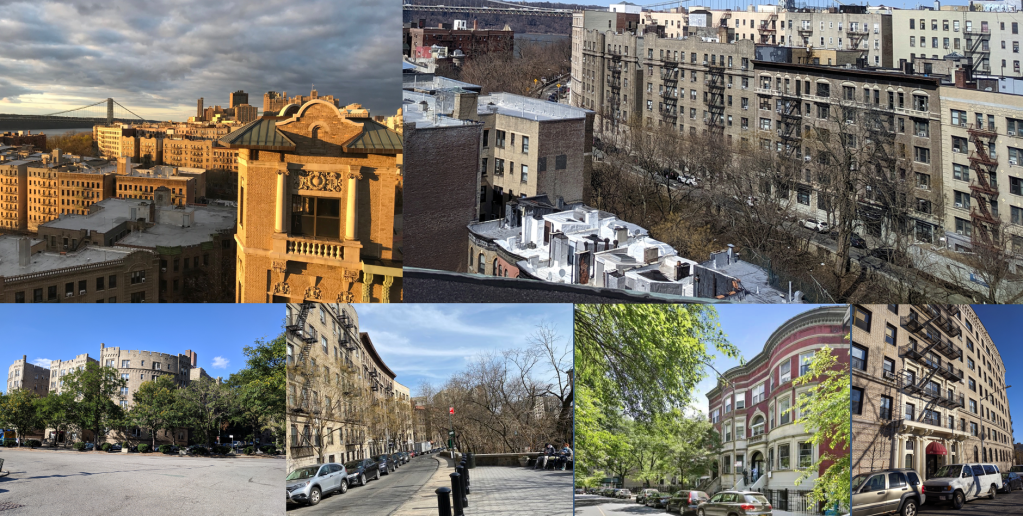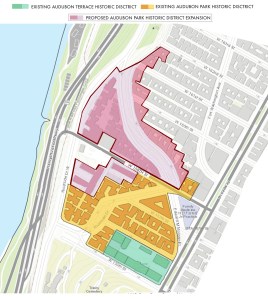The Upper Riverside Residents’ Alliance, a grass-roots organization dedicated to preserving, maintaining, and celebrating Riverside Drive between 155th and 165th Streets, is asking the New York City’s Landmarks Preservation Commission to extend the Audubon Park Historic District to include buildings west and north of the current designation. The resulting historic district will then encompass the entire winding stretch of the “inner” Riverside Drive between West 155th Street and 162nd Street, a continuous streetscape with a distinct sense of place.
Historically, the designated area and extension area shared a winding path to urbanization from early 19th-century fields and woodland through late 19th-century suburban homes to a 20th-century cityscape. Extending the current historic district will increase the architectural typologies that illustrate that journey and expand the cultural narrative beyond a Eurocentric story to an inclusive one that highlights the neighborhood’s racial, ethnic, and financial diversity. Extending the historic district will also preserve and protect 857 Riverside Drive, the oldest local structure. Dating to 1851, the Italianate style house is the only surviving example of the architectural typology the Audubon family favored when they converted their farm, Minnie’s Land, into suburban Audubon Park. It is also the sole remaining link to an Abolitionist community active in northern Manhattan in the 1850s.
Click here to see how you can help!
Upcoming Events
In anticipation of submitting a Request for Evaluation (RFE) to the Landmarks Preservation Commission in May, members of the Upper Riverside Residents’ Alliance are presenting several free events in the next few weeks.
AUDUBON PARK: The Neighborhood Manhattan Forgot (A Virtual Walking Tour)
Click to Register
Wednesday, April 28 @ 7:00 p.m. (ET)
In this virtual walking tour, presented by Save Harlem Now!, author and historian Matthew Spady will focus on the Audubon Park neighborhood’s journey from farmland to cityscape and take a look at why the present-day footprint and streetscape disrupt Manhattan’s grid. He’ll share historic as well as present-day photographs to illustrate the evolving architectural typologies, from the Audubon’s farmhouse to the Italianate villas that populated suburban Audubon Park, to the apartment buildings, museum complex, and church that cover the neighborhood today.
Ferry to Freedom: The Abolitionist of Washington Heights (A Virtual Walking Tour)
Click to Register
Monday, May 3 at 1:00 PM
Wednesday, May 5 at 9:00 AM

Step back in time with journalist Joseph Amodio and local historian Matthew Spady as they bring the Underground Railroad (UGRR) to life, in this virtual Jane’s Walk that will reveal the people, places, and history of a little-known colony of abolitionists who helped develop Washington Heights. “Walk” with them from the Hudson (site of a sugar refinery and ferry run by a documented agent of the UGRR) to uptown’s only abolitionist church to the home at 857 Riverside Drive, the last remnant of this community still standing—and threatened today with demolition.The virtual walk will last approximately 1 hour, though may extend longer, depending on questions from attendees.
Celebrating the life and activism of Jane Jacobs, Jane’s Walk NYC 2021 is sponsored by the Municipal Arts Society, and will take place from May 3 to 9, 2021. Jane’s Walks are free.
Lobbies, Entrances, and Evocative Names: Marketing Apartments in 1910 (A Virtual Walking Tour)
Click to Register

Between 1908 and 1911, a group of twelve Beaux Arts apartment houses replaced most of suburban Audubon Park in upper Manhattan, but with so many choices, how was a renter to know which building was best? Join historian and author Matthew Spady on this virtual walk through today’s Audubon Park Historic District, to learn how speculative developers marketed their new buildings with a host of amenities ranging from romantic names, handsome entrances, and uniformed staff to paneled dining rooms, dumbwaiters, and wall safes—all with the objective of drawing solidly middle-class tenants uptown.


